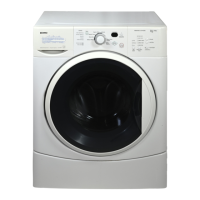4
Washing Procedures
1
Sort laundry into loads that can be washed together.
(Mesh bag not included.)
2 Prepare items for washing.
Empty pockets.•
Brush off lint and dirt. Shake out rugs and beach towels.•
Close zippers, fasten hooks, tie strings and sashes, and •
remove non-washable trims and ornaments.
Mend rips and tears to prevent further damage during •
washing.
Turn knit items inside out to prevent pilling.•
See Stain Removal Guide in this guide for safe, success-•
ful stain removal instructions.
4 Add laundry load to washer.
3 Pretreat stains and heavy soil.
To reduce the risk of fi re, electric shock or in-
jury to persons, read the IMPORTANT SAFETY INSTRUCTIONS
in this Use and Care Guide before operating your washer.
Sort items by recommended cycle and water tempera-•
ture.
Separate white, light and colorfast items from dark and •
non-colorfast items.
Separate items that shed lint from items that attract •
lint. Casual, synthetic, knit, and corduroy items will pick
up lint from towels, rugs, and chenille bedspreads.
Separate heavily soiled items from lightly soiled items.•
Separate lacy, sheer, loosely knit, or delicate items from •
durable items.
Do not machine wash items containing fi berglass. Small •
particles of fi berglass left in the drum may transfer to
fabrics in other loads and cause skin irritation.
Place delicate and small items such as bras, hosiery and •
baby socks in a mesh bag.
Combine large and small items in a load.•
Load large items fi rst. Large items should not be more •
than half the total wash load.
Washing single items such as a sweater, towel or jeans •
is ineffi cient and may cause an out-of-balance load.
Add 1 or 2 similar items to help balance the load.
Wash a single heavy item such as a king-sized com-•
forter, bedspread or sleeping bag separately.
The washer can be fully loaded, but the items should •
not be tightly packed. The door should close easily.

